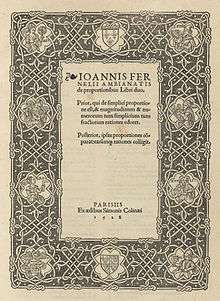Jean Fernel

Jean François Fernel (in Latin, Fernelius) (1497 – 26 April 1558)[1] was a French physician who introduced the term "physiology" to describe the study of the body's function. He was the first person to describe the spinal canal. The lunar crater Fernelius is named after him.
Fernel suggested that taste buds are sensitive to fat, an idea which only recently has been shown to be correct.[2][3]
Life
He was born at Montdidier, and after receiving his early education at his native town and at Claremont,[4] he entered the College of Sainte-Barbe, Paris. At first he devoted himself to mathematical and astronomical studies; but from 1534 he gave himself up entirely to medicine, in which he graduated in 1530. His general erudition, and the skill and success with which he sought to revive the study of the old Greek physicians, gained him a reputation, and ultimately the office of physician to the court. Catherine de' Medici, wife of King Henry II of France, sought his advice regarding their difficulty in conceiving a child. He practiced with success, and at his death at Fontainebleau in 1558 left behind him a large fortune.[5]
Works


Fernel's Cosmotheoria (1528) records a determination of a degree of arc of the meridian, which he made by counting the revolutions of his carriage wheels on a journey between Paris and Amiens. Using his measurements he calculated the circumference of the earth to within one percent of the correct value. His works on mathematical and astronomical subjects also include Monalosphaerium, sive astrolabii genus, generalis horarii structura et usus(1526), and De proportionibus (1528).[5]
His medical works included De naturali parte medicinae (1542), De vacuandi ratione (1545), De abditis rerum causis (1548) which included a chapter on angelology and demonology.[6] What has been called his "crowning work",[7] Universa Medicina, comprising three parts, the Physiologia (developed from the De naturali parte), the Pathologia, and the Therapeutice.
Notes
- ↑ Today in Science
- ↑ Potential Taste Receptor for Fat Identified. Scientific American
- ↑ Mattes, Richard D. (2009). "Is There a Fatty Acid Taste?". Annual Review of Nutrition. 29: 305–27. doi:10.1146/annurev-nutr-080508-141108. PMC 2843518
 . PMID 19400700.
. PMID 19400700. - ↑ Hockey, Thomas (2009). The Biographical Encyclopedia of Astronomers. Springer Publishing. ISBN 978-0-387-31022-0. Retrieved August 22, 2012.
- 1 2
 "Fernel, Jean François". Encyclopædia Britannica. 10 (11th ed.). 1911. p. 281.
"Fernel, Jean François". Encyclopædia Britannica. 10 (11th ed.). 1911. p. 281. - ↑ Nancy G. Siraisi, The Clock and the Mirror: Girolamo Cardano and Renaissance medicine Princeton University Press (1997) ISBN 0691011893, p. 160.
- ↑ Welch, G. R. (2008). "In Retrospect: Fernel's Physiologia". Nature. 456 (7221): 446. doi:10.1038/456446b.
References
 This article incorporates text from a publication now in the public domain: Chisholm, Hugh, ed. (1911). "Fernel, Jean François". Encyclopædia Britannica. 10 (11th ed.). Cambridge University Press. p. 281.
This article incorporates text from a publication now in the public domain: Chisholm, Hugh, ed. (1911). "Fernel, Jean François". Encyclopædia Britannica. 10 (11th ed.). Cambridge University Press. p. 281.
Further reading
| Wikimedia Commons has media related to Jean Fernel. |
Granit, Ragnar (1970–80). "Fernel, Jean François". Dictionary of Scientific Biography. 4. New York: Charles Scribner's Sons. pp. 584–6. ISBN 978-0-684-10114-9.
External links
- Clinical Cardiology: Fernel
- Jean Francois Fernel: Biography
- Jean Fernel by Victor de Beauvillé (in French)